CONSUMER ALERT
LEAD FOUND IN TWO FIDGET SPINNERS SOLD AT TARGET
Several fidget spinners were tested for lead content by a CPSC-accredited laboratory. The fidget spinners were analyzed in accordance with CPSC-CH-E1001-8.3 using Inductively Coupled Plasma Mass Spectrometry (ICP/MS). The toys that tested for high levels of lead were then re-tested a second time to confirm the results. The results of the second test are included in this report.
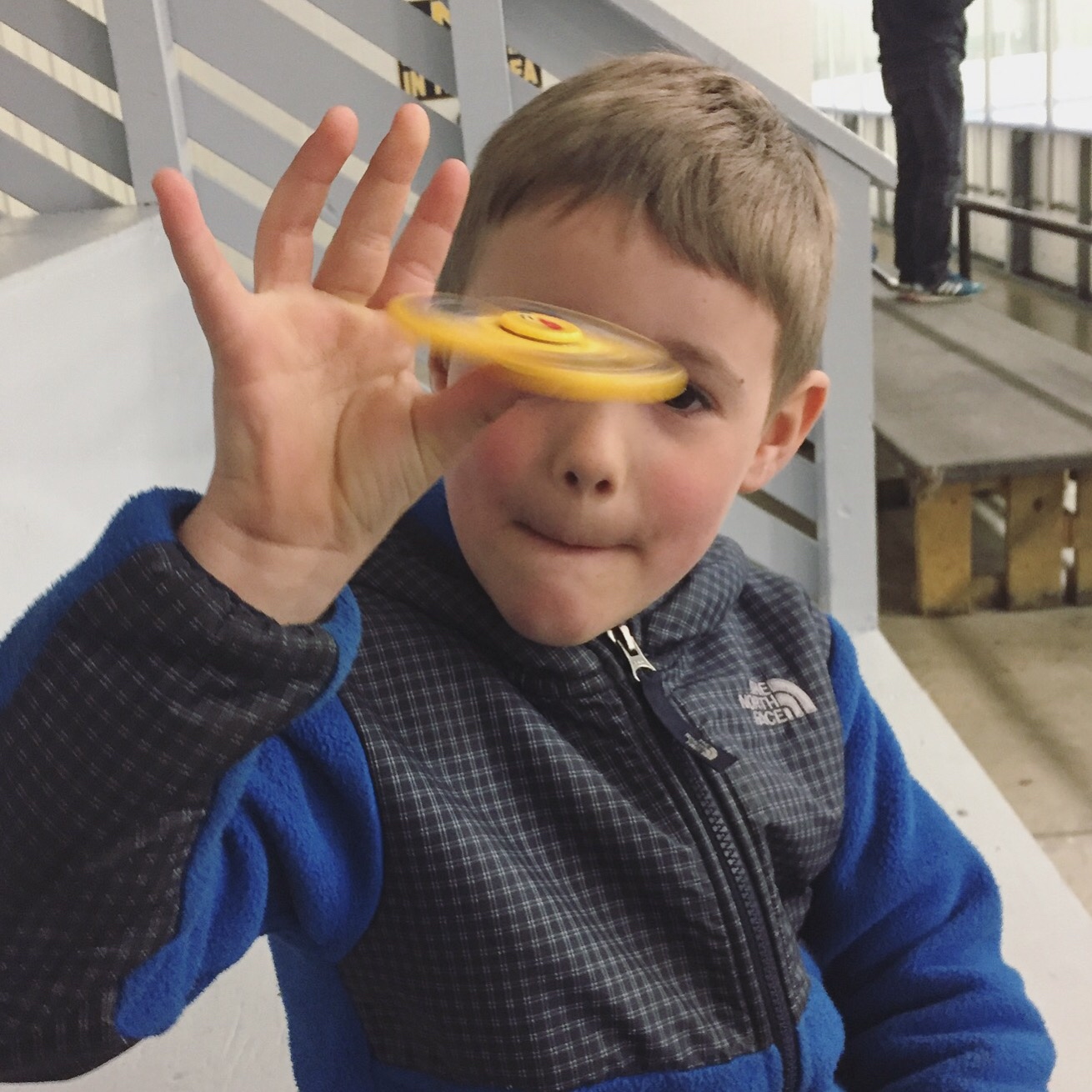
U.S. PIRG Education Fund found two fidget spinner models that contained high levels of lead for sale at Target stores across the country. Parents and consumers need to know about these lead-laden toys, especially because when we alerted Target and the toy’s distributor, Bulls i Toy, to our findings, they refused to address the problem. The toxic fidget spinners are still available both in toy aisles at Target stores and on its website. Incredibly, Target and Bulls i Toy defend their inaction by pointing to the Consumer Product Safety Commission’s (CPSC) declaration that fidget spinners are not technically “children’s products” subject to legal limits for lead. We advise parents to remove the two fidget spinners that we identified from children’s use and join us in calling on Target to immediately recall them.
The fidget spinners were analyzed in accordance with CPSC rules. CPSC-CH-E1001-8.3 using Inductively Coupled Plasma Mass Spectrometry (ICP/MS). The toys that tested for high levels of lead were then re-tested to confirm the results. The results of the second test are included in our report.
WHAT SHOULD CONSUMERS DO?
- Check your house for the two fidget spinners we found that have high levels of lead. Stop using them immediately.
- If you find these fidget spinners, place them in a bag out of children’s reach.
- Watch out for any recall notice and follow the instructions of the recall.
- Sign our petition to Target, calling on them to immediately issue a public recall of these two fidget spinners, to remove them from store shelves and their website. Target should also give customers a full refund.
- Subscribe to email recall updates from the CPSC and other U.S. government safety agencies available at www.recalls.gov

Use the navigation below to jump to specific sections of this resource.
What fidget spinners did we find with lead in them?
How do I know if my fidget spinner has lead in it?
What should I do if I think our fidget spinner(s) contain lead?
How would my child get exposed to lead from fidget spinners?
How should I dispose of our fidget spinners?
How can I help make sure that all fidget spinners are safe?
More information on lead, federal standards for lead, and children’s products.
These are the two fidget spinners we found at Target that tested for unsafe levels of lead.
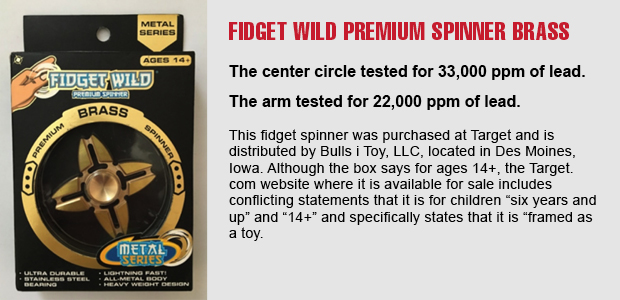
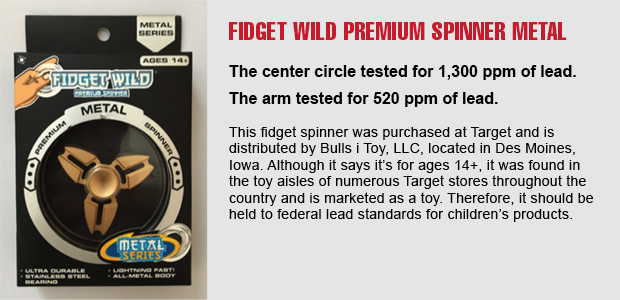
How do I know if my Fidget Spinner has lead in it?
Unfortunately, parents won’t be able to know if a fidget spinner has lead in it simply by looking at it. The first thing parents can do is look for a disclosure on the label or packaging that the fidget spinner is intended for use by kids age 12 and under. Children’s products for kids under 12 are subject to a certification process through which the manufacturer must certify that the product has been third-party tested for all safety requirements, including the CPSC standard for lead for safety of children’s products. There are thousands of fidget spinners on the market and we did not test every single one, so we cannot say for certain that any particular fidget spinner is safe.
What should I do if I think our Fidget Spinner(s) contain lead?
Parents and consumers should immediately take the two, lead-laden fidget spinners identified by U.S. PIRG Education Fund from their children. They should secure them in a bag, place the bag out of children’s reach, and watch out for any recall notice and, if a recall is issued, follow the instructions of the recall. They should also call Target’s customer service line (1-800-440-0680) and tell them to take our lead test results seriously and treat all fidget spinners as children’s products since they have play value for kids 12 and under. Consumers can also go to the U.S. PIRG Education Fund website to learn more about the dangers of lead and sign our petition calling on Target to recall these fidget spinners and to treat all fidget spinners as children’s products.
How would my child get exposed to lead from fidget spinners?
Children can be exposed to lead from toys in several different ways. One common way is by licking, eating, or chewing on a toy. Lead will dissolve in saliva, so children can get lead into their mouths if they lick or chew on a toy that contains lead. A second way is by scratching up the toy. Through normal use, most toys will be scratched and rubbed. When lead particles are scratched off toys, they bind with dust and other particles. That dust can be breathed in by children. This is similar to how children can be exposed to lead-based paint.
Should I get my child tested for lead poisoning if we bought one of the Fidget Spinners that contain too much lead?
We would encourage any parent who is worried that their child has been exposed to lead — or any other toxic substance — to talk to their family doctor.
How should I dispose of our Fidget Spinners?
Take the fidget spinners you suspect contain lead away from your children. Secure them in a bag and place them out of the children’s reach. Watch for any notice of a recall of the fidget spinners and then follow the instructions in the recall.
How can I help make sure that all Fidget Spinners are safe?
It’s clear that fidget spinners should be treated as children’s products since they have play value for kids 12 and under, and they should be regulated as such. U.S. PIRG Education Fund has launched a petition calling on Target to treat fidget spinners as children’s products and immediately recall fidget spinners that contain very high amounts of lead. You can sign our petition which is on the U.S. PIRG Education Fund website. In addition, we will continue to make the case for the CPSC to reverse its decision and treat all fidget spinners as children’s products subject to federal lead standards.
BACKGROUND INFORMATION
Elemental lead is a metal occurring naturally in soils and rocks. It has a variety of commercial uses including in batteries, plastics, and radiation shielding. In the past, lead was also added to gasoline and paint. Because of lead’s toxicity, in 1978 it was banned in household paint, in products marketed to children, and in dishes and cookware in the United States. Lead is not discernible by sight or smell. Lead exposure is particularly damaging for young children because of its impact on development. Even low levels of lead in blood have been shown to undermine IQ, attentiveness, and academic achievement. The Centers for Disease Control and Prevention (CDC) makes clear that any amount of lead in a child’s blood is unsafe. Moreover, since the effects of lead exposure cannot be reversed, it is especially important to prevent lead exposure to children in the first place.
Unfortunately, toys can pose a risk in part because lead is used in other countries and can be found in imported products. Additionally, lead may be incorporated into plastic. Lead is used to soften plastic and make it more flexible, but when the plastic is exposed to sunlight, air, or detergents, the chemical bond between the lead and plastic breaks down, forming lead dust. Children can inhale or come in contact with this dust when they put toys in or near their mouths.
FEDERAL STANDARDS FOR LEAD
With a few exceptions, federal law requires that all children’s products manufactured after August 2011 contain no more than 100 parts per million (ppm) of total lead content in all accessible parts. The CPSC defines accessible parts as parts that a child could reach through “normal and reasonably foreseeable use and abuse of the product.”
Paint or similar surface coatings on all children’s products are subject to a limit of 90 ppm of total lead. (Household paints are also subject to this rule.)
Exceptions to these standards include metal components of bicycles, which cannot contain more than 300 ppm of lead. Components in electronic devices, some used children’s products, inaccessible parts, and other items are exempt from the lead standard.
Note that these limits do not meet the recommendations of the American Academy of Pediatrics (AAP), which recommends that all products intended for use by children contain no more than trace amounts of lead, defined as 40 ppm, the high end of typical lead concentrations in uncontaminated soil.
What Is A Children’s Product And Why Do We Disagree with the Manufacturer and the CPSC?
The Consumer Product Safety Improvement Act of 2008 and implementing CPSC regulations state: “The law defines a “children’s product” as a consumer product designed or intended primarily for children 12 years of age or younger. In determining whether a consumer product is primarily intended for a child 12 years of age or younger, the following factors will be considered:
- A statement by the manufacturer about the intended use of the product, including a label on the product, if such statement is reasonable.
- Whether the product is represented in its packaging, display, promotion, or advertising as appropriate for use by children 12 years of age or younger.
- Whether the product is commonly recognized by consumers as being intended for use by a child 12 years of age or younger.
- The Age Determination Guidelines (pdf) issued by the Commission staff in September 2002, and any successor to such guidelines.
When they claim that the fidget spinners containing excess lead are “general use products,” not “children’s products” the manufacturer Bulls i, the retailer Target and the CPSC place too much reliance on the manufacturer’s age recommendation. They ignore the in-store and website marketing, they ignore the Age Determination Guidelines and, most of all, they ignore “Whether the product is commonly recognized by consumers as being intended for use by a child 12 years of age or younger.”
As any parent or teacher can attest, children play with fidget spinners all the time. Their parents look at them as children’s products. Simply labeling a fidget spinner as “14 years and over” should not, with nothing more, provide manufacturers and retailers a defense against making a fidget spinner that meets lead standards for children’s products.

Screenshot from our communication with the CPSC that these fidget spinners are general use products, not toys.
Alarmingly, when U.S. PIRG Education Fund notified the CPSC about the elevated lead levels in the fidget spinners, the CPSC responded in an email that these fidget spinners are general use products, not toys, so the CPSC will not hold them to federal lead standards. Belying that statement, U.S. PIRG Education Fund staff found these fidget spinners sold in the toy aisle of Target stores and on the Target.com website, which includes a statement that the product is intended for children ages 6 and up. Furthermore, common sense dictates that fidget spinners are meant for kids and therefore should be classified as toys. U.S. PIRG Education Fund calls on the CPSC to classify these fidget spinners as toys and hold them to the federal standard for lead in children’s products.
Supporting evidence why we believe that Target, Bulls I Toys and the CPSC should take action and regulate these products as toys
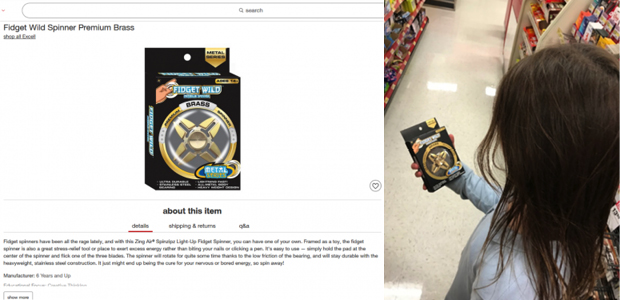
Screenshot from Target.com website (above, left). Photo (above, right) of the Fidget Wild Premium Spinner Brass in a Taget store, marketed as a toy.
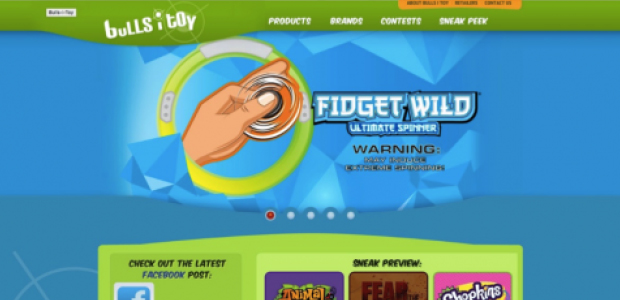
Screenshot from the BullsiToy.com website where Fidget Wild products are found clearly on a website for toys.